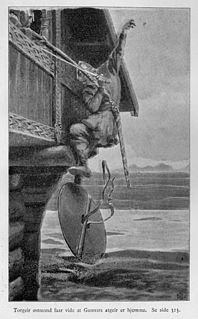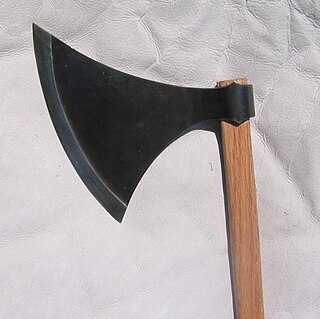 W
WThe angon was a type of javelin used during the Early Middle Ages by the Anglo-Saxons, Franks, Goths, and other Germanic peoples. It was similar to, and probably derived from, the pilum used by the Roman army and had a barbed head and long narrow socket or shank made of iron mounted on a wooden haft.
 W
WAn atgeir, sometimes called a "mail-piercer" or "hewing-spear", was a type of polearm in use in Viking Age Scandinavia and Norse colonies in the British Isles and Iceland. The word is related to the old norse geirr, meaning spear. It is usually translated in English as "halberd", but most likely closer resembled a bill or glaive during the Viking age. Another view is that the term had no association with a specific weapon until it is used as an anachronism in saga literature to lend weight to accounts of special weapons. Later the word was used for typical European halberds, and even later multipurpose staves with spearheads were called atgeirsstafir.
 W
WA bearded axe, or Skeggøx refers to various axes, used as a tool and weapon, as early as the 6th century AD. It is most commonly associated with Viking Age Scandinavians. The hook or "beard", i. e. the lower portion of the axe bit extending the cutting edge below the width of the butt, provides a wide cutting surface while keeping the overall weight of the axe low.
 W
WThe Dane axe is an early type of battle axe, primarily used during the transition between the European Viking Age and early Middle Ages. Other names for the weapon include English long axe, Danish axe, and hafted axe.
 W
WThe francisca is a throwing axe used as a weapon during the Early Middle Ages by the Franks, among whom it was a characteristic national weapon at the time of the Merovingians from about 500 to 750 and is known to have been used during the reign of Charlemagne (768–814). Although generally associated with the Franks, it was also used by other Germanic peoples of the period, including the Anglo-Saxons; several examples have been found in England.
 W
WSeax is an Old English word for "knife". In modern archaeology, the term seax is used specifically for a type of small sword, knife or dagger typical of the Germanic peoples of the Migration period and the Early Middle Ages, especially the Saxons, whose name derives from the weapon. These vary considerably in size, but are mostly all-purpose tools and weapons, often carried by women as well as men.
 W
WThe Seax of Beagnoth is a 10th-century Anglo-Saxon seax. It was found in the inland estuary of the Thames in 1857, and is now at the British Museum in London. It is a prestige weapon, decorated with elaborate patterns of inlaid copper, brass and silver wire. On one side of the blade is the only known complete inscription of the twenty-eight letter Anglo-Saxon runic alphabet, as well as the name "Beagnoth" in runic letters. It is thought that the runic alphabet had a magical function, and that the name Beagnoth is that of either the owner of the weapon or the smith who forged it. Although many Anglo-Saxon and Viking swords and knives have inscriptions in the Latin alphabet on their blades, or have runic inscriptions on the hilt or scabbard, the Seax of Beagnoth is one of only a handful of finds with a runic inscription on its blade.
 W
WThe spear or lance, together with the bow, the sword, the seax and the shield, was the main equipment of the Germanic warriors during the Migration Period and the Early Middle Ages.
 W
WThe Migration Period sword was a type of sword popular during the Migration Period and the Merovingian period of European history, particularly among the Germanic peoples and was derived from the Roman era spatha. It later gave rise to the Carolingian or Viking sword type of the 8th to 11th centuries AD.